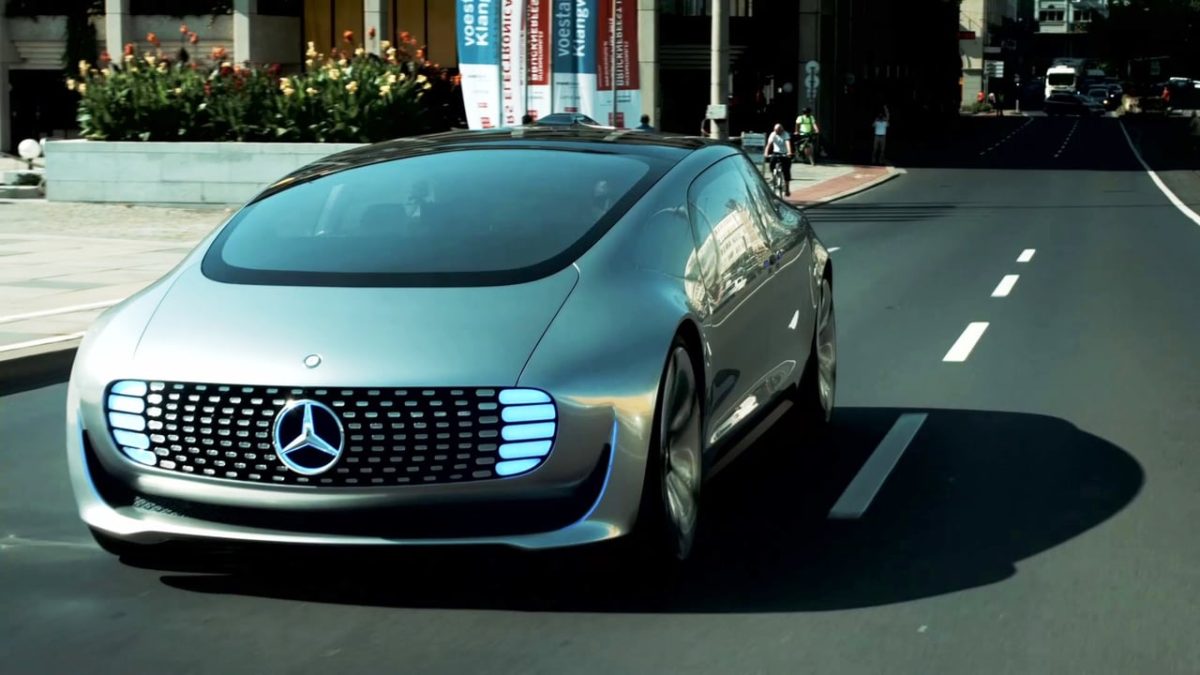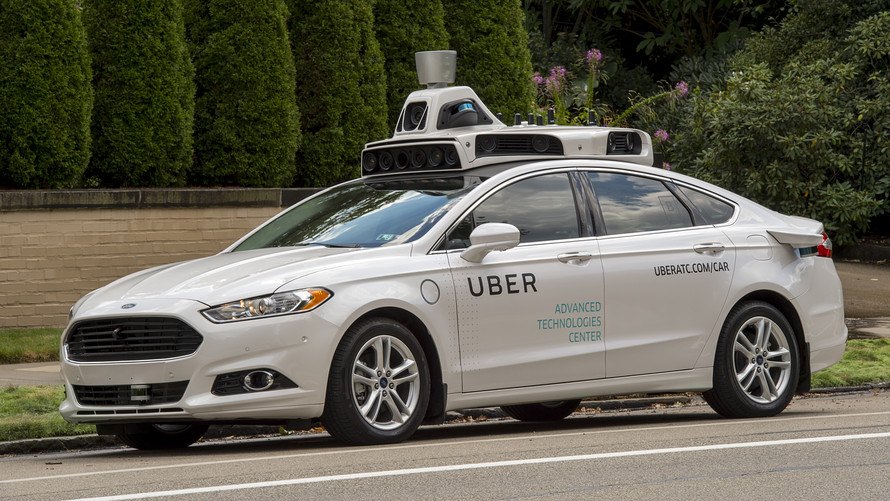Introduction
Autonomous cars are vehicles that are able to fulfill the main transporting capabilities of traditional cars without direct human control [1]. They are also known as driverless, self-driving, or robotic cars. Scientists and engineers have been developing this technology since the 1960s, and some sources even report that the development started as early as the 1920s [2]. In 2010, Google tested this new kind of vehicle on Californian roads with its “Google car” [3]. In 2012, a dozen of Google’s self-driving cars drove 300,000 miles under computer control without a single accident [4]. Since 2014, self-driving cars have been commercially available [5]. Other, more traditional carmakers are expecting their first autonomous cars to be available around 2020 [6–11]. Note that semi-autonomous cars are already available from these carmakers [12]. For example, these cars are equipped with basic forward-collision warning systems or automatic braking features. The Insurance Institute for Highway Safety has seen a 7 percent and a 14 percent reduction in crashes for these systems respectively [13]. Besides being used in cars, the autonomous technology can also be found in other ground vehicles, such as subway systems [14], tractors [15], and space vehicles [16]. Studies show that at least 90% of all car crashes are due to human factors [17]. The introduction of the autonomous car could therefore have a tremendous impact as they do not rely on direct human control.
Future Implications
When the autonomous car is introduced, many aspects of current society are prone to change. Ethically, benefits lie in everyone being allowed to use this mode of transport, meaning it would not matter if the occupants were under age, over age, unlicensed, blind, distracted, intoxicated, or otherwise impaired. Furthermore, the infrastructure will change gradually: the Institute of Electrical and Electronics Engineers (IEEE) envisions an absence of traffic signs and lights since autonomous cars would not need them [18]. Dr. Alberto Broggi, IEEE senior member and professor of computer engineering at the University of Parma, successfully piloted a self-driving car on a 13,000-kilometer road trip from Parma to Shanghai [19]. He points out that robotic cars will require less infrastructure, not more, stating “The cars that we tested on the route from Parma to Shanghai had no maps, and had sensing primarily based on cameras. In both cases, the cars have no help from the infrastructure”. IEEE also believes that autonomous cars could eliminate the need for driver’s licenses [18]. At some point, it is probable that conventional vehicles with human drivers will be limited and then excluded [20]. In addition, the idea about car ownership could change. Knowing that cars sit unused about 95% of the time, there could be a lot of improvement in how we would allocate resources [21]. For example, the car can become a service rather than a possession [22]. It can then be summoned by smartphone, making owning a car obsolete.
Additionally, Morgan Stanley found that the use of autonomous cars would contribute to $1.3 trillion in annual savings in the U.S. alone [23]. Worldwide, savings are estimated to be $5.6 trillion due to less fuel consumption, less congestion costs, less accidents, and a productivity gain attributed to saved time [24]. On the other hand, McKinsey & Company stated that the introduction of autonomous or near-autonomous cars has a potential economic impact of $200 billion to $1.9 trillion per year in 2025 [25]. To put this in perspective, the lowest estimate is still more than the total government expenditure of the Netherlands [26]. Furthermore, commuters would gain an average of 50 minutes of free time a day, and 90% of all accidents would be prevented. Consequently, McKinsey & Company found that we would save 30,000–150,000 lives per year from potentially fatal traffic accidents. That is equal to over 187 times the population of Vatican City every year [27]. Besides saving lives directly, 300 million tons of CO2 emissions will be saved, which is equal to half of the current commercial aviation emissions [28].
According to Deloitte the improvement of technology is accelerating exponentially [29]. For humans this kind of growth is counterintuitive, and thus difficult to comprehend [30]. According to Ray Kurzweil, the 100 years of the 21st century we experience will be equivalent to 20,000 years of progress at today’s rate, which is a thousand times greater than the 20th century [31]. Technological unemployment (unemployment primarily caused by technological change) might become reality. With the introduction of the driverless car, taxi drivers might be the first ones to lose their jobs in favor of this technology. “[They] might very well be the equivalent of nineteenth-century horse-and-cart men, blacksmiths and all the other related trades that were swept aside as the automobile conquered the world” [32]. McKinsey noted that the two largest industries hurt by the introduction would be car insurers and car repair shops. However, Jay L. Zagorsky, a research scientist at The Ohio State University, states that McKinsey missed the tremendous impact on police forces around the world [33]. As more than half of all contacts with the police are traffic-related, and most of these issues will become nonexistent, the number of law enforcement personnel can be cut in half without reducing public safety, says Zagorsky. Nonetheless, more than half of preeminent experts do not believe that technology will displace more jobs than it creates in 2025 [34]. This would mean that technological unemployment would not take place until at least 2025. Conversely, MIT’s Erik Brynjolfsson and Andrew McAfee do think that less jobs will become available and unemployment rates will grow [35]. This is not necessarily a bad thing: people used to work less hours per year before the industrialization [36]. In ancient Greece they even tried to not work at all, spending most of their time drinking [37]. If technological unemployment does become reality, a solution is evident. By guaranteeing a basic income, paid with money that has been saved with the introduction of the autonomous car, the unemployed can continue to have an acceptable standard of living. One could even argue that governments should subsidize the technology as it will earn the government more money than it would cost to facilitate this [38].
Conclusion
In conclusion, the extent of the socioeconomic impact of the introduction of autonomous cars may be the greatest mankind has ever seen: (1) there will be a reduced amount of accidents and deaths; (2) money, time, and fuel will be saved; (3) there will be less traffic, less traffic signs and lights, and possibly less roads; and (4) the idea about car ownership will change, possibly converting from ownership to a service [39]. The amount of lives saved each year is already a reason enough to accept the advent of the autonomous car. Moreover, the amount of money saved can be used to raise allowances for people that may lose their job in favor of this technology. Since the introduction of the autonomous car thus has many benefits, it should be introduced as soon as possible.
References
-
wiseGEEK. (2015). What Is a Driverless Car?. Retrieved 15 September 2016, from http://www.wisegeek.com/what-is-a-driverless-car.htm
-
News.google.com (1926). The Milwaukee Sentinel. Retrieved 14 September 2016, from https://news.google.com/newspapers?id=unBQAAAAIBAJ&sjid=QQ8EAAAAIBAJ&pg=7304,3766749&hl=en
-
Markoff, J. (2010). Google Cars Drive Themselves, in Traffic. Nytimes.com. Retrieved 14 September 2016, from http://www.nytimes.com/2010/10/10/science/10google.html
-
Lardinois, F. (2012). Google’s Self-Driving Cars Complete 300K Miles Without Accident, Deemed Ready For Commuting. TechCrunch. Retrieved 14 September 2016, from http://techcrunch.com/2012/08/07/google-cars-300000-miles-without-accident/
-
Maisto, M. (2014). Induct Now Selling Navia, First Self-Driving Commercial Vehicle. Eweek.com. Retrieved 14 September 2016, from http://www.eweek.com/innovation/induct-now-selling-navia-first-self-driving-commercial-vehicle.html
-
Fowler, S. (2015). Renault and Nissan confirm autonomous cars by 2020. Auto Express. Retrieved 14 September 2016, from http://www.autoexpress.co.uk/renault/90707/renault-and-nissan-confirm-autonomous-cars-by-2020
-
Preisinger, I. (2013). Daimler aims to launch self-driving car by 2020. Reuters. Retrieved 14 September 2016, from http://www.reuters.com/article/2013/09/08/us-autoshow-frankfurt-daimler-selfdrive-idUSBRE98709A20130908
-
Elmer, S. (2013). BMW Targets 2020 for Self-Driving Cars » AutoGuide.com News. AutoGuide.com News. Retrieved 14 September 2016, from http://www.autoguide.com/auto-news/2013/02/bmw-targets-2020-for-self-driving-cars.html
-
Johnson, D. (2013). Audi predicts self-driving cars by 2020. Leftlanenews.com. Retrieved 14 September 2016, from http://www.leftlanenews.com/audi-predicts-self-driving-cars-by-2020.html
-
Cheng, R. (2014). General Motors President sees self-driving cars by 2020 – CNET. CNET. Retrieved 14 September 2016, from http://www.cnet.com/news/general-motors-president-sees-self-driving-cars-by-2020/
-
Mack, E. (2014). Elon Musk: Don’t fall asleep at the wheel for another 5 years – CNET. CNET. Retrieved 14 September 2016, from http://www.cnet.com/news/elon-musk-sees-autonomous-cars-ready-sooner-than-previously-thought/
-
Kessler, A., & Vlasic, B. (2015). Semiautonomous Driving Arrives, Feature by Feature. Nytimes.com. Retrieved 15 September 2016, from http://www.nytimes.com/2015/04/03/automobiles/semiautonomous-driving-arrives-feature-by-feature.html
-
The Road to Self-Driving Cars – Today’s crash-avoidance systems are the mile markers to tomorrow’s autonomous vehicles, in Consumer Reports. 2014.
-
Siemens. (2008). Driverless Subways. Siemens.com. Retrieved 15 September 2016, from http://www.siemens.com/innovation/en/publikationen/publications_pof/pof_spring_2008/tailored_solutions/fahrerlose_ubahn.htm
-
Kopytoff, V. (2014). Driverless tractors on the farm. Fortune. Retrieved 14 September 2016, from http://fortune.com/2014/12/29/driverless-tractors-on-the-farm/
-
Webster, G. (2013). NASA’S Mars Curiosity Debuts Autonomous Navigation. Jpl.nasa.gov. Retrieved 14 September 2016, from http://www.jpl.nasa.gov/news/news.php?release=2013-259
-
Smith, B.W. (2013). Human error as a cause of vehicle crashes. Cyberlaw.stanford.edu. Retrieved 14 September 2016, from http://cyberlaw.stanford.edu/blog/2013/12/human-error-cause-vehicle-crashes
-
Newcomb, D. You won’t need a driver’s license by 2040. 2012 18 September 2012 [cited 2015 11 May]; Available from: http://edition.cnn.com/2012/09/18/tech/innovation/ieee-2040-cars/index.html.
-
Drielsma, M., From Europe to China: Intelligent driverless vehicle reaches end goal in Shanghai after 13 000 km. 2010.
-
Martin, R. (2013). How Self-Driving Cars Will Change The World. Forbes. Retrieved 14 September 2016, from http://www.forbes.com/sites/pikeresearch/2013/11/13/how-self-driving-cars-will-change-the-world/
-
Davies, A. (2015). Self-Driving Cars Will Make Us Want Fewer Cars. WIRED. Retrieved 15 September 2016, from http://www.wired.com/2015/03/the-economic-impact-of-autonomous-vehicles/
-
Baydere, B.A., et al. Car-Sharing Service Using Autonomous Automobiles. 2014.
-
Morganstanley.com. (2015). Autonomous Cars: The Future Is Now. Retrieved 14 September 2016, from http://www.morganstanley.com/articles/autonomous-cars-the-future-is-now/
-
Zhang, B. (2014). [INFOGRAPHIC] Autonomous Cars Could Save The US $1.3 Trillion Dollars A Year. Business Insider. Retrieved 15 September 2016, from http://www.businessinsider.com/morgan-stanley-autonomous-cars-trillion-dollars-2014-9
-
Manyika, J.C., Michael; Bughin, Jacques; Dobbs, Richard; Bisson, Peter; Marrs, Alex, Disruptive technologies: Advances that will transform life, business, and the global economy. 2013, McKinsey & Company. p. 78-83.
-
Government.nl. (2015). Expenditure in 2014. Retrieved 14 September 2016, from http://www.government.nl/issues/budget/revenue-and-expenditure-in-2014/expenditure-in-2014
-
Uffici di Presidenza S.C.V. (2015). Population. Vaticanstate.va. Retrieved 15 September 2016, from http://www.vaticanstate.va/content/vaticanstate/en/stato-e-governo/note-generali/popolazione.html
-
Ecometrica, Introduction of aviation into the European Union emissions trading scheme. 2009. p. 5.
-
Hagel, J., et al., From exponential technologies to exponential innovation. Deloitte Center for the Edge, San Jose, California. http://www2. deloitte. com/content/dam/Deloitte/es/Documents/sector-publico/Deloitte_ES_Sector-Publico_From-exponentialtechnologies-to-exponential-innovation.pdf, 2013.
-
Big Think Editors. (2011). Big Idea: Technology Grows Exponentially. Retrieved 14 September 2016, from http://bigthink.com/think-tank/big-idea-technology-grows-exponentially
-
Kurzweil, R., & Meyer, C. (2003). Understanding the Accelerating Rate of Change. Kurzweilai.net. Retrieved 14 September 2016, from http://www.kurzweilai.net/understanding-the-accelerating-rate-of-change
-
Lewis, N. (2015). The driverless car and the fall of man. Spiked-online.com. Retrieved 14 September 2016, from http://www.spiked-online.com/newsite/article/the-driverless-car-and-the-fall-of-man/16887
-
Zagorsky, J.L. (2015). Cops may feel biggest impact from driverless car revolution. The Conversation. Retrieved 14 September 2016, from http://theconversation.com/cops-may-feel-biggest-impact-from-driverless-car-revolution-38767
-
Smith, A., & Anderson, J. (2014). AI, Robotics, and the Future of Jobs. Pew Research Center’s Internet & American Life Project. Retrieved 15 September 2016, from http://www.pewinternet.org/2014/08/06/future-of-jobs/
-
Brynjolfsson, E. and A. McAfee, Race against the machine: How the digital revolution is accelerating innovation, driving productivity, and irreversibly transforming employment and the economy. 2012: Brynjolfsson and McAfee.
-
Schor, J. Preindustrial workers worked fewer hours than today’s. Groups.csail.mit.edu. Retrieved 14 September 2016, from http://groups.csail.mit.edu/mac/users/rauch/worktime/hours_workweek.html
-
Wittermans, S. (2014). Werken is voor de dommen. Eoswetenschap.eu. Retrieved 14 September 2016, from http://eoswetenschap.eu/artikel/werken-voor-de-dommen
-
Rand.org. (2015). The Dream Drive. Retrieved 14 September 2016, from http://www.rand.org/blog/rand-review/2015/01/the-dream-drive.html
-
Diamandis, P. (2014). Self-driving Cars are Coming. Forbes. Retrieved 15 September 2016, from http://www.forbes.com/sites/peterdiamandis/2014/10/13/self-driving-cars-are-coming/


